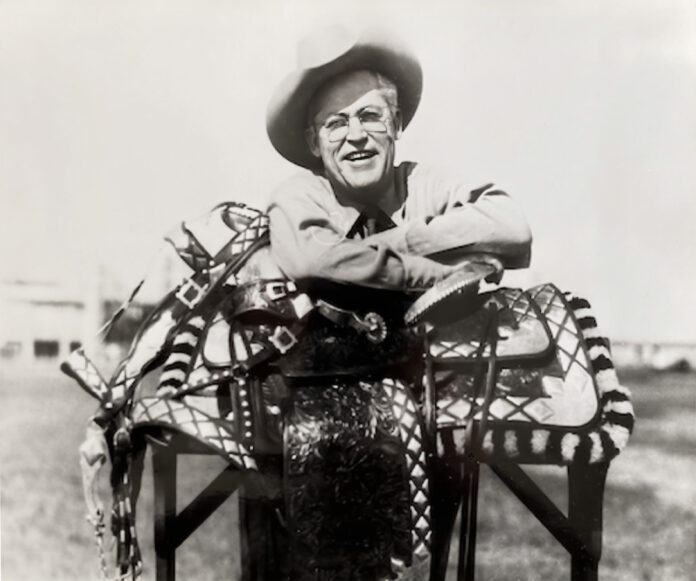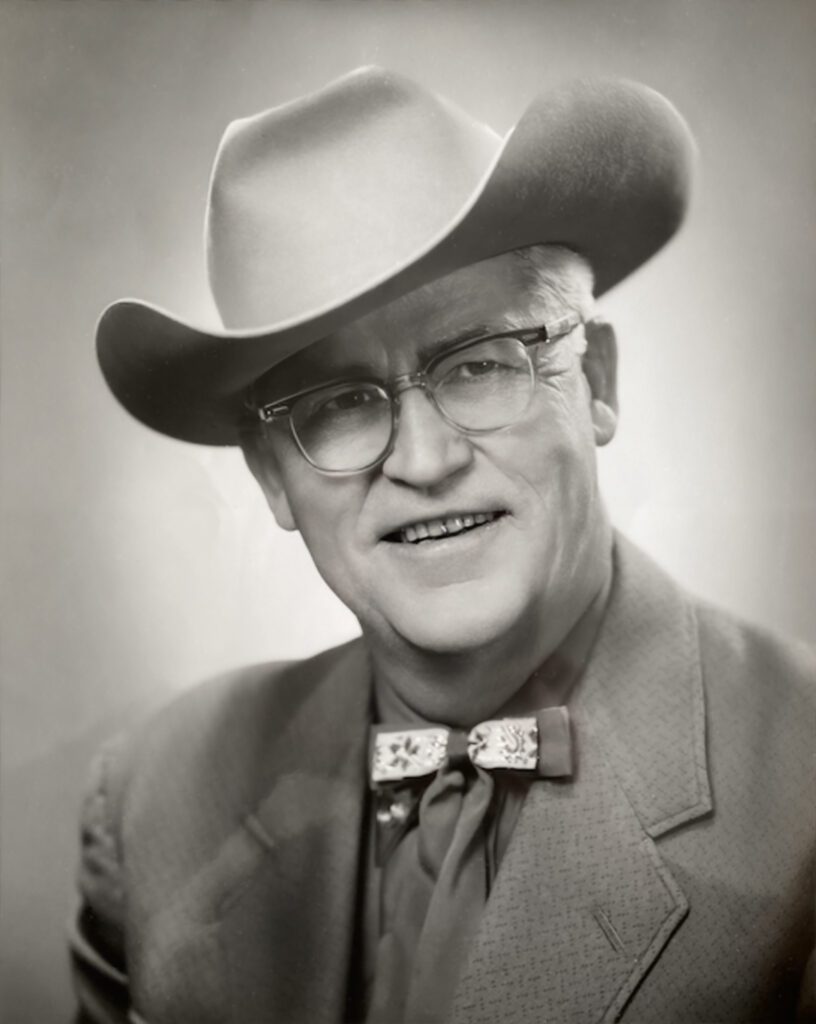
I’m proud and happy to report that this is my 200th column for Oklahoma Magazine. Since it seems to me a fact I should acknowledge, I’ve been wondering what I could write about to make this month’s piece a little, well, special.
Then, on March 2, I did a live broadcast of my radio show, Swing on This, with Bob Wills’ Texas Playboys from the Cain’s Ballroom in Tulsa, and it came to me all at once. If I wrote about the 100th anniversary of the venerable ballroom, as well as the 90th anniversary of Wills and the Texas Playboys’ first visit to Tulsa, I’d have two big pop-culture milestones to tie in with my own more modest one.
So here we are.
Those who follow Western swing music know that there’s a weekend celebration of Bob Wills’ early March birthday every year at the Cain’s. For the reasons I just noted, the 2024 version of this get-together was special. While the musical style Wills pioneered and perfected was not created in Oklahoma – its birthplace was Fort Worth, Texas – Tulsa was, as I like to say on my radio program, the place where Western swing grew up.
There were a couple of reasons for that. First, it was the city where Bob and his Texas Playboys finally got established. Second, it was because of their ongoing relationship with Tulsa radio station KVOO, a 25,000-watt (later 50,000-watt) flamethrower whose nighttime signal reached a huge swath of America, especially throughout the West, Midwest and Southwest. And, thanks to the first hour of every Thursday and Saturday night Playboys dance being broadcast live over KVOO each week, the Cain’s achieved a kind of mythic status, especially among those who only knew it from the radio. It may have been, at its heart, just an Oklahoma honky-tonk, but in the collective imagination of that simpler era, it took on mighty proportions. And the primary reason was Wills and his Playboys, who not only reached far beyond Tulsa with their Thursday and Saturday night one-hour dance broadcasts from the place, but also appeared there six days a week for noontime KVOO broadcasts that anyone could attend for free. It’s been said that in summer during the band’s heyday, the days of open windows rather than air-conditioning, a person could walk down the street anywhere in Tulsa and not miss a note of the lunch-hour shows.
As Brett Bingham and I noted in our book on the Cain’s, Twentieth-Century Honky-Tonk (Babylon Books, 2020), Wills and his group didn’t immediately zero in on the ballroom when they hit town on Friday, February 9, 1934; they had other, more immediate, concerns. Some six months before their Tulsa trip, Bob had left a good job as a fiddler and bandleader with the Light Crust Doughboys, which broadcast daily in Fort Worth under the auspices of Burris Mill, home of Light Crust Flour. (In those days when home baking was much more prevalent, the flour market was an extremely competitive one.) Some other Doughboys had followed him, and they’d started a new band dubbed the Playboys, playing dances and broadcasting over a Waco, Texas radio station. But Bob’s vindictive former boss, W. Lee “Pappy” O’Daniel (later a Texas governor and U.S. Senator), dogged their trail – to such an extent that he had just gotten them fired from Oklahoma City radio station WKY after less than a week of residency.
So, on that cold and foggy February morning, Bob, business manager O.W. Mayo, and the band’s trumpeter and announcer Everett Stover hit the road to Tulsa, leaving the rest of the band behind in an Oklahoma City rooming house. Dispirited and uncertain, they were headed for a new station called KTUL, where they had an appointment. But Mayo, who was driving, came up with the idea of first going by the giant Tulsa outlet KVOO, whose wattage was some 50 times that of the upstart KTUL.

It was a long shot, born of desperation, but it worked. The three managed to talk KVOO radio station manager W. B. Way into giving the Texas Playboys a midnight tryout. The rest of the band members were called, and they arrived in Tulsa, instruments in tow, in time to go on at 12 a.m. And with that radio audition, Wills and his Texas Playboys began their celebrated long-term relationship with Tulsa.
(The strength of KVOO’s nighttime signal is reflected in the answer to an announcement made on that very first broadcast, which offered a photo of the band to the person who wrote to the station from the farthest point away. The winner was a woman from Oakland, California.)
The connection with the Cain’s Ballroom, however, wouldn’t happen for another 11 months. Bob and the boys were playing a second-story dancehall in downtown Tulsa called the Pla-Mor, and gigging all around the area, when they were hired by a nurses’ association at Morningside Hospital (now Hillcrest) to play a benefit dance at the Cain’s on January 1, 1935. Mayo and the musicians quickly realized that the Cain’s – twice the size of the Pla-Mor – would make a dandy base of operations, and Mayo quickly cut a deal that would allow the Playboys to move their dances there, which is how the Cain’s Ballroom became nothing less than the Carnegie Hall of Western Swing.
It hadn’t always been the Cain’s. Built in 1924 by Tulsa pioneer Tate Brady, the sandstone-and-brick structure was supposed to have been a garage for Hupmobile autos. It’s unclear, however, whether any vehicles made by the Hupp Motor Car Company ever rolled onto its floor. Soon after its construction, Brady turned the place into a dancehall called the Louvre – and, despite fairly exhaustive research, neither Brett Bingham nor I have ever been able to find out why Brady named it after the famous Paris art museum, if that’s indeed the case.
Brady, who left what turned out to be a tainted legacy, died the year after the building was finished. In 1930, a dance instructor named Madison “Daddy” Cain leased the building from Brady’s estate, renaming the place the Cain’s Dancing Academy. There, along with his wife, Alice, and main instructor Howard Turner, Cain gave ballroom-dancing lessons until a stroke incapacitated him a few years later. However, Turner continued the dance instruction (and negotiated the agreement with Mayo); lessons were still going on in the building when O.W. Mayo took over the Cain’s lease, two years later, and they continued there for years afterward.
There are a lot of people who did a lot to get the Cain’s to its 100-year mark, including – but certainly not limited to – Larry Shaeffer, who took the venue over as a young concert promoter in the mid-’70s (starting the Bob Wills birthday-weekend celebrations in the early ‘90s) and kept it going until 1999, along with the Rodgers family, who purchased it in the early 2000s and almost immediately made wide-ranging, and much-needed, renovations. Chad and Hunter Rodgers continue to successfully book a wide-ranging array of acts into the Cain’s, just as Shaeffer did.
I think, though, that sometimes O.W. Mayo doesn’t get quite the credit he deserves in all of this. Not only was he the one who got Wills and his Playboys on KVOO; he also (1) negotiated the deal that gave the group the Cain’s for its home base and (2) ended up owning the place from 1944 until 1972. In addition, he’s the man responsible for the unique gallery of long-ago performers who look down from the ballroom’s walls. For a long time, that array also included a photo of KVOO’s W.B. Way; and still today, if you take a good look around, among the stars of 70-plus years ago you’ll see a big picture of Howard Turner, as well as one of O.W. Mayo himself.
Which, I believe, is exactly how it should be.






















